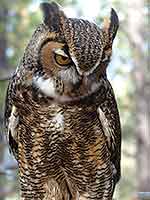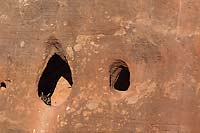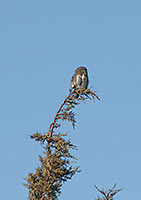On many a January night, a stillness blankets the Canyon Country, enveloping the landscape in a silence so clear you can also hear the stars above. Everything seems to slow down because of the cold, but there are those that prowl the stillness in search of a meal.
Throughout the long cold nights there is a surprising amount of activity. Go to the Cisco Desert or up to Sand Flats or find a canyon with some sandy floor or one dusted with recent snow. You’ll find a myriad of sign, tracks and scat left from desert dwellers. Mice and kangaroo rats forage for seeds, cottontails and jackrabbits nibble on greenery and predators seek an easy meal.
Of all the nocturnal predators, I have the most affiliation for owls. Maybe it’s their distinctive calls which shatter an evening’s silence or their silent flight as they zero in on prey. I’ve spent many a night out calling for owls and listening for their responses. Some nights you have to sort out sounds, background noises or those that could be attributed to shifting ice, snow falls or creatures I hope to never encounter.
One of the classic owl calls belongs to the great horned owl. Its deep hoots, “Who who-who, who-who-who” are unmistakable, clear as the night sky. Owlers will tell you the old mnemonic “Who’s awake, me, too” is a good guideline but one that comes with a lot of variation.
At first, I was surprised seeing that these great horneds don’t call from an upright position. They bend forward, almost horizontal to the ground and raise their tail feathers for balance before they let out a series of hoots. 
Named for their large ear tufts, great horned owls are a common bird found in the canyons and woodlands of southeastern Utah. Nesting in rocky alcoves, broken tree snags or old raptor nests, these owls don’t build their own nest. A shallow scrape in some rocky alcove or an abandoned hawk’s nest are all they need to lay their eggs in. These owls and Canada geese compete for the title of Earliest Breeder in Canyon Country. Both may lay eggs in late winter and incubate their young during spring snowstorms.
Another “eared” owl that inhabits the Canyon Country is the long-eared owl. In winter, these owls may roost in dense brush and share their overnight accommodations with other long-eareds in a communal setting.
 Differentiating long-eareds from great horneds is easy – the long-eareds are smaller in size and have orangish facial disks. Plus, a long-eared has ear tufts set closer together, whereas the great horneds are farther apart. And the call seals the deal; the classic long-eared owl call is a deep, drawn out “Whoooot” that is spaced several seconds apart.
Differentiating long-eareds from great horneds is easy – the long-eareds are smaller in size and have orangish facial disks. Plus, a long-eared has ear tufts set closer together, whereas the great horneds are farther apart. And the call seals the deal; the classic long-eared owl call is a deep, drawn out “Whoooot” that is spaced several seconds apart.
Besides these larger owls, there are smaller ones such as the northern pygmy, northern saw-whet and western screech-owl that live here in winter. Don’t let the small size of the pygmy owl influence your opinion of their tenacity – these owls easily take prey twice their size. Saw-whets and screech owls seek smaller prey, mainly mice and voles, but hunger will drive these owls to prey upon whatever they can.
So here’s my advice. On the next clear, cold night, bundle up and go outside. Find a quiet canyon or area with little noise. Stand as still as possible and enjoy the sparkling stars, the silence of the evening and keep an ear alert for the hooting calls of Canyon Country owls.